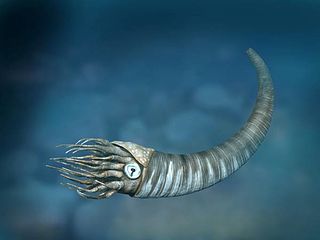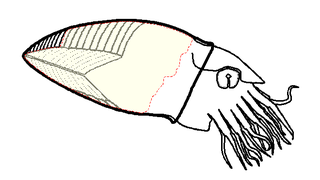
The siphuncle is a strand of tissue passing longitudinally through the shell of a cephalopod mollusk. Only cephalopods with chambered shells have siphuncles, such as the extinct ammonites and belemnites, and the living nautiluses, cuttlefish, and Spirula. In the case of the cuttlefish, the siphuncle is indistinct and connects all the small chambers of that animal's highly modified shell; in the other cephalopods it is thread-like and passes through small openings in the septa (walls) dividing the camerae (chambers). Some older studies have used the term siphon for the siphuncle, though this naming convention is uncommon in modern studies to prevent confusion with a mollusc organ of the same name.

Nautiloids are a group of marine cephalopods (Mollusca) which originated in the Late Cambrian and are represented today by the living Nautilus and Allonautilus. Fossil nautiloids are diverse and speciose, with over 2,500 recorded species. They flourished during the early Paleozoic era, when they constituted the main predatory animals. Early in their evolution, nautiloids developed an extraordinary diversity of shell shapes, including coiled morphologies and giant straight-shelled forms (orthocones). Only a handful of rare coiled species, the nautiluses, survive to the present day.

Endocerida is an extinct nautiloid order, a group of cephalopods from the Lower Paleozoic with cone-like deposits in their siphuncle. Endocerida was a diverse group of cephalopods that lived from the Early Ordovician possibly to the Late Silurian. Their shells were variable in form. Some were straight (orthoconic), others curved (cyrtoconic); some were long (longiconic), others short (breviconic). Some long-shelled forms like Endoceras attained shell lengths close to 6 metres (20 ft). The related Cameroceras is anecdotally reported to have reached lengths approaching 9 metres (30 ft), but these claims are problematic. The overwhelming majority of endocerids and nautiloids in general are much smaller, usually less than a meter long when fully grown.
Discosorida are an order of cephalopods that lived from the beginning of the Middle Ordovician, through the Silurian, and into the Devonian. Discosorids are unique in the structure and formation of the siphuncle, the tube that runs through and connects the camerae (chambers) in cephalopods, which unlike those in other orders is zoned longitudinally along the segments rather than laterally. Siphuncle structure indicated that the Discosorida evolved directly from the Plectronoceratida rather than through the more developed Ellesmerocerida, as did the other orders. Finally and most diagnostic, discosorids developed a reinforcing, grommet-like structure in the septal opening of the siphuncle known as the bullette, formed by a thickening of the connecting ring as it draped around the folded back septal neck.

Plectronocerida is a primitive order from which subsequent cephalopod orders are ultimately derived.
The Ellesmerocerida is an order of primitive cephalopods belonging to the subclass Nautiloidea with a widespread distribution that lived during the Late Cambrian and Ordovician.
Ectenolites is a genus of small, slender, cylindrical Ellesmeroceratids that resemble Ellesmeroceras but are smaller and proportionally narrower. Septa, as typical for ellesmerocerids, are close spaced with shallow lobes on either flank. The body chamber is proportionally long, the shell itself slightly compressed. The dorsal side at the beginning of the shell, opposite the aperture and body chamber, is strongly convex so to produce a sense of endogastric curvature with the apex and siphuncle aligned.
Clarkoceras is a genus of breviconic ellesmerocerid cephalopods, one of only two genera known to have crossed from the Late Cambrian, Trempealeauan, into the Early Ordovician, Gasconadian. ; the other being Ectenolites.

The Ellesmeroceratidae constitute a family within the cephalopod order Ellesmerocerida. They lived from the Upper Cambrian to the Lower Ordovician. They are characterized by straight and endogastric shells, often laterally compressed, so the dorso-ventral dimension is slightly greater than the lateral, with close spaced sutures having shallow lateral lobes and a generally large tubular ventro-marginal siphuncle with concave segments and irregularly spaced diaphragms. Connecting rings are thick and layered, externally straight but thickening inwardly with the maximum near the middle of the segment so as to leave concave depressions on internal siphuncle molds. Septal necks are typically orthochoanitic but vary in length from almost absent (achoanitic) to reaching halfway to the previous septum (hemichoanitic) and may even slope inwardly (loxochoanitic).
Baltoceratidae is an extinct family of orthoconic cephalopods belonging to the subclass Nautiloidea endemic to what would be Asia, Australia, Europe, North America, and South America during the Ordovician living from about 480–460 mya, existing for approximately 20 million years.

Orthoceratoidea is a major subclass of nautiloid cephalopods. Members of this subclass usually have orthoconic (straight) to slightly cyrtoconic (curved) shells, and central to subcentral siphuncles which may bear internal deposits. Orthoceratoids are also characterized by dorsomyarian muscle scars, extensive cameral deposits, and calciosiphonate connecting rings with a porous and calcitic inner layer.
The cephalopods have a long geological history, with the first nautiloids found in late Cambrian strata, and purported stem-group representatives present in the earliest Cambrian lagerstätten.
Jiagouceras is a genus of early primitive cephalopods from the Upper Cambrian of China, assigned to the Plectronoceratidae. The shell is small, nearly straight with a slight endogastric curvature and compressed cross section. The siphuncle is close to the ventral margin, with segments expanded into the chambers.
Plectronoceratoidea is a superorder or subclass containing primitive nautiloids from the Late Cambrian and Early Ordovician. This group is best considered a paraphyletic grade of early cephalopods, as it contains the ancestors of subsequent post-Cambrian cephalopod orders.
Shangtungendoceras is a conical plectronoceratoid cephalopod from the Upper Cambrian of north-eastern China, described by Sun (1937) as a primitive endoceroid. Because of its apparently poor preservation its ordinal and familial position is uncertain. It could be included in either the Plectronocerida, family Plectronoceratidae, or the Ellesmerocerida, family Ellesmeroceratidae. On the other hand, Teichert (1964) included Shungtangendoceras in the Ellesmoerocatidae.
Acaroceratidae is family of Upper Cambrian (Trempealeauan) nautiloid cephalopods included in the Ellesmerocerida that contains two known genera, Acaroceras and Weishanuceras, both found in northern China.
Cyrtocerinida is an order of Ordovician nautiloid cephalopods. The order includes the families Cyrtocerinidae and Eothinoceratidae, as well as the genera Bathmoceras and Rummoceras.
Protactinocerida is a proposed order of Late Cambrian nautiloid cephalopods. Their fossils have only been found in the Late Cambrian of North China, a diversity pattern similar to other early cephalopod orders.

Multiceratoidea is a major subclass or superorder of Paleozoic nautiloid cephalopods. Members of this group can be characterized by nautilosiphonate connecting rings, with an organic inner layer and outer layer of calcitic spherules and blades, similar to the modern nautilus. The earliest-diverging multiceratoids have oncomyarian muscle scars, though several orders trend towards a ventromyarian condition. Multiceratoid shells are generally short and curled, with a relatively small aperture (opening). Cameral deposits are never found among the multiceratoids, though several orders are known to bear endosiphuncular deposits within their siphuncles.

Bisonocerida is an order of Ordovician to Silurian nautiloid cephalopods. Members of this order were originally placed in the order Endocerida, but later investigation argued that this broad usage of Endocerida was a polyphyletic assemblage encompassing two different groups of independent origin. Bisonocerida was differentiated from Endocerida in 2012 in order to resolve this issue.







